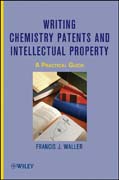
Writing chemistry patents and intellectual property: a practical guide
Waller, Francis J.
This book, based on a short course the author gives for the American ChemicalSociety, provides the necessary insights, strategies, and examples of how to write a patent so it is not rejected by the United States Patent and Trade Office (USPTO) or the patent does not have invalid claims. The author believes hehas developed the necessary methodology to make this a reality. Overall, the books approach can be broken down into the following general themes: (1) Understand the patent examiners rejection process (2) Review how a comprehensive literature search should be structured (3) Educate the patent examiner (4) Writethe specification so one skilled in the art can duplicate your results without undue experimentation. This makes for a practical handbook guiding an inventor through the writing process with examples from issued patents. ÍNDICE: Preface. 1. Background and Historical Perspective about Intellectual Property. 2. Brief Introduction to Vocabulary and Definitions. 3. Your First Decision: Trade Secret or Patent? 4. What Comes First: a Provisional or Non-Provisional Patent Applications? 5. Reasons for Patent Office Rejections. 6. Reasons for Invalid Patents. 7. Examples of Patent Specifications. 8. Writing the Patent Application. 9. An Examination of Claim Format. 10. Why You Need Confidentiality Agreements. 11. Practical Information about Copyrights and Trademarks. 12. Global Patent Filing and Patenting Strategy. 13. What Academic Science Faculty Should Know about Patents and Copyrights. 14. Intellectual PropertyResources. 15. Book Summary and On Your Own. 16. Responses to Questions at End of Chapters. 17. Patent Appendix. Index.
- ISBN: 978-0-470-49740-1
- Editorial: John Wiley & Sons
- Encuadernacion: Cartoné
- Páginas: 238
- Fecha Publicación: 02/09/2011
- Nº Volúmenes: 1
- Idioma: Inglés
